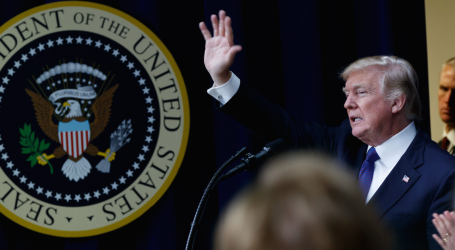California’s “Jungle Primary” Could Turn Democrats’ Enthusiasm Into a Fiasco
vesmil/iStock
Looking for news you can trust?Subscribe to our free newsletters.
Since Donald Trump’s election, liberal activism has exploded across Southern and Central California, including in traditionally Republican bastions such as Orange County. In response, the Democratic Congressional Campaign Committee has drawn up an aggressive battleground map that targets 10 districts as part of its effort to flip the House in November. Now, an overabundance of eager Democratic candidates—67 so far—have entered into the 14 California House races currently held by a Republican. But this surge could turn Democrats into victims of their own success.
In previous elections, when Democrats often did not contest these seats or ran sacrificial candidates who were easily outspent and outvoted. “We were begging people to come to the ballot so at least we would have a Democratic option,” says Drew Godinich, a DCCC spokesman. “And now there are all of these people running.”
While that’s an encouraging indicator of the enthusiasm of the Democratic base, it could backfire due to California’s “jungle primary” system. In 2010, California voters decided to switch from a traditional partisan primary to a system in which the two biggest vote getters, regardless of their party affiliation, advance to the general election. Supporters of jungle, or “top two,” primaries say they open up the field to candidates who don’t have to pander to hyperpartisan voters. But this approach can dilute a party’s votes if its supporters don’t get behind a single frontrunner before the primary. In districts where several Democrats are currently duking it out, a heavily contested primary in June could effectively hand the election to a Republican in November.
This has happened before. Then in 2012, Democrats suffered an embarrassing defeat in a Southern California congressional district where they held an edge in voter registration. Four Democrats ran, split the vote, and then-Redlands Mayor Pete Aguilar finished third behind two Republicans in the primary. In 2014, history nearly repeated itself. Again, four Democrats ran, and again, they split the primary vote. Meanwhile, according to Brad Roe, a Southern California strategist who had worked for a Republican candidate in the race, “Aguilar phoned it in, thinking he had it in the bag.” Aguilar only narrowly landed in second place in the primary—just 200 votes ahead of a Republican.
“What we hope is that the candidates will set aside their personal goals and do what’s best for our district, and for the country.” The lesson of those messy races hasn’t been lost on California Democrats. In January, Rep. Mark Takano (D-CA), who represents the 41st district, told Politico, “We don’t want to get Aguilar-ed.”
In 2016, seeing the potential for a similar threat brewing in the Santa Barbara area’s District 24, the Democratic Congressional Campaign Committee took the unusual step of of boosting candidate Salud Carbajal before the primary “to ensure that he got to the general election,” says Godinich. He went on to win the general election with 53 percent of the vote. The DCCC is still monitoring the top-two threat closely, Goodnich says, and it “reserves the right to get involved in the primaries if necessary.”
Primary fights are shaping up in several California districts. Earlier this year, Democrats rejoiced after Republican Reps. Darrell Issa and Ed Royce announced their retirements. But the celebration has been short-lived. Both Issa and Royce’s districts went for Hillary Clinton in 2016, but they still lean Republican, and the Democratic field is split between five candidates in Issa’s district and eight in Royce’s. In Rep. Mimi Walter’s Orange County district, seven Democrats have announced their candidacy. If another Republican joins the race before the March 9 filing deadline, the Democrats may have a problem.
A bitter fight has already broken out between Harley Rouda and Hans Keirstead, the most prominent Democrats aiming to unseat Rep. Dana Rohrabacher. Their supporters have been throwing out anonymous allegations, accusing the other candidate of lies and various wrongdoing. Rouda, a businessman and attorney, launched a pair of attack ads on Keirstead, a stem cell researcher, earlier this month. Their battle spilled out into the open last weekend at the Democratic convention in San Diego, where Keirstead supporters and staffers tried to prevent Rouda and other candidates in their district from gathering signatures to prevent the state Democratic Party from endorsing a candidate in the race.
Next week, the four top Democratic contenders in Rohrabacher’s district will participate in a public debate. It will be Rouda and Keirstead’s first public appearance together, and fireworks may be on display.
With so many Democrats running for election, and some of them training their fire on each, liberal activists are left wondering how to cure a problem that their own enthusiasm helped cause. In Royce’s district, the local chapter of the progressive group Indivisible has held meetings to brainstorm ways to avoid a top-two fiasco and determine it will endorse any candidates. “We also have plans to meet with the candidates and ask if they will either pledge to drop out, or if elected, to only serve two terms,” says Marian Bodner, the head of the chapter. “Just to put pressure on some of them.” She thinks that a term-limit pledge might pacify candidates who would be willing to put their ambitions on hold until future election cycles.
On Friday night, progressive activists in Issa’s district are hosting a “candidate viability forum” for the five Democratic contenders. Ellen Montanari, who has organized protests in front of Issa’s local office in Vista for more than a year, says some pointed questions will be asked, including one she sees as especially important: “What makes you think you’re the one who’s going to save the republic here? Because it looks like so long as all of you think so, we’re going to go down in flames—and this will remain a Republican seat.”
Montanari hopes the candidate forum will start to whittle down the field. “Franky, I’d like to get it down to one, but that’s never going to happen,” she says. “It’s hard [for candidates] to sit back and say, ‘I won’t run.’” She adds, with a touch of annoyance, “What we hope is that the candidates will set aside their personal goals and do what’s best for our district, and for the country.”





